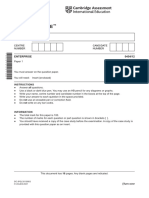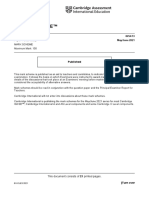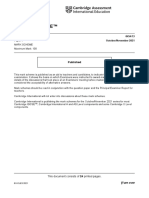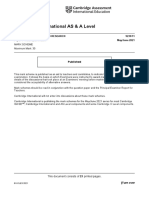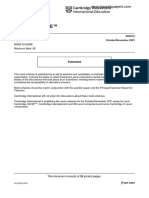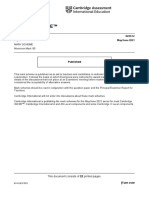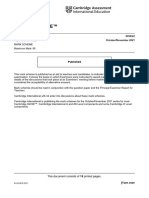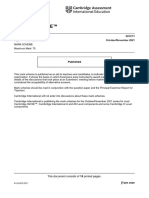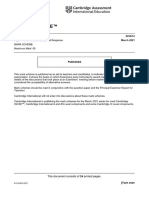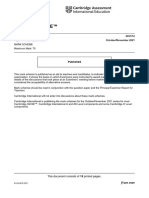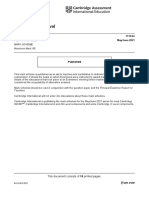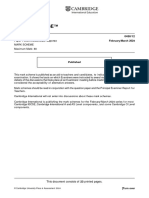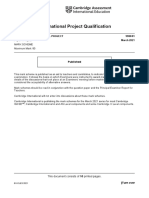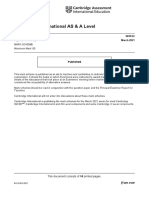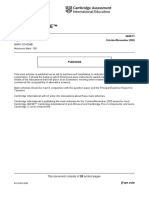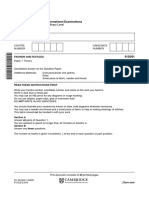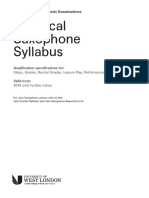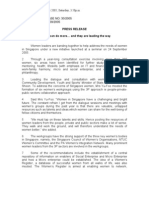Cambridge IGCSE™: Enterprise 0454/11 May/June 2021
Cambridge IGCSE™: Enterprise 0454/11 May/June 2021
Uploaded by
Sraboni ChowdhuryCopyright:
Available Formats
Cambridge IGCSE™: Enterprise 0454/11 May/June 2021
Cambridge IGCSE™: Enterprise 0454/11 May/June 2021
Uploaded by
Sraboni ChowdhuryOriginal Title
Copyright
Available Formats
Share this document
Did you find this document useful?
Is this content inappropriate?
Copyright:
Available Formats
Cambridge IGCSE™: Enterprise 0454/11 May/June 2021
Cambridge IGCSE™: Enterprise 0454/11 May/June 2021
Uploaded by
Sraboni ChowdhuryCopyright:
Available Formats
Cambridge IGCSE™
ENTERPRISE 0454/11
Paper 1 Case Study May/June 2021
MARK SCHEME
Maximum Mark: 100
Published
This mark scheme is published as an aid to teachers and candidates, to indicate the requirements of the
examination. It shows the basis on which Examiners were instructed to award marks. It does not indicate the
details of the discussions that took place at an Examiners’ meeting before marking began, which would have
considered the acceptability of alternative answers.
Mark schemes should be read in conjunction with the question paper and the Principal Examiner Report for
Teachers.
Cambridge International will not enter into discussions about these mark schemes.
Cambridge International is publishing the mark schemes for the May/June 2021 series for most Cambridge
IGCSE™, Cambridge International A and AS Level components and some Cambridge O Level components.
This document consists of 24 printed pages.
© UCLES 2021 [Turn over
0454/11 Cambridge IGCSE – Mark Scheme May/June 2021
PUBLISHED
Generic Marking Principles
These general marking principles must be applied by all examiners when marking candidate answers. They should be applied alongside the
specific content of the mark scheme or generic level descriptors for a question. Each question paper and mark scheme will also comply with these
marking principles.
GENERIC MARKING PRINCIPLE 1:
Marks must be awarded in line with:
• the specific content of the mark scheme or the generic level descriptors for the question
• the specific skills defined in the mark scheme or in the generic level descriptors for the question
• the standard of response required by a candidate as exemplified by the standardisation scripts.
GENERIC MARKING PRINCIPLE 2:
Marks awarded are always whole marks (not half marks, or other fractions).
GENERIC MARKING PRINCIPLE 3:
Marks must be awarded positively:
• marks are awarded for correct/valid answers, as defined in the mark scheme. However, credit is given for valid answers which go beyond the
scope of the syllabus and mark scheme, referring to your Team Leader as appropriate
• marks are awarded when candidates clearly demonstrate what they know and can do
• marks are not deducted for errors
• marks are not deducted for omissions
• answers should only be judged on the quality of spelling, punctuation and grammar when these features are specifically assessed by the
question as indicated by the mark scheme. The meaning, however, should be unambiguous.
GENERIC MARKING PRINCIPLE 4:
Rules must be applied consistently, e.g. in situations where candidates have not followed instructions or in the application of generic level
descriptors.
© UCLES 2021 Page 2 of 24
0454/11 Cambridge IGCSE – Mark Scheme May/June 2021
PUBLISHED
GENERIC MARKING PRINCIPLE 5:
Marks should be awarded using the full range of marks defined in the mark scheme for the question (however; the use of the full mark range may
be limited according to the quality of the candidate responses seen).
GENERIC MARKING PRINCIPLE 6:
Marks awarded are based solely on the requirements as defined in the mark scheme. Marks should not be awarded with grade thresholds or
grade descriptors in mind.
© UCLES 2021 Page 3 of 24
0454/11 Cambridge IGCSE – Mark Scheme May/June 2021
PUBLISHED
Social Science-Specific Marking Principles
(for point-based marking)
1 Components using point-based marking:
• Point marking is often used to reward knowledge, understanding and application of skills. We give credit where the candidate’s answer
shows relevant knowledge, understanding and application of skills in answering the question. We do not give credit where the answer shows
confusion.
From this it follows that we:
(a) DO credit answers which are worded differently from the mark scheme if they clearly convey the same meaning (unless the mark
scheme requires a specific term)
(b) DO credit alternative answers/examples which are not written in the mark scheme if they are correct
(c) DO credit answers where candidates give more than one correct answer in one prompt/numbered/scaffolded space where extended
writing is required rather than list-type answers. For example, questions that require n reasons (e.g. State two reasons …).
(d) DO NOT credit answers simply for using a ‘key term’ unless that is all that is required. (Check for evidence it is understood and not used
wrongly.)
(e) DO NOT credit answers which are obviously self-contradicting or trying to cover all possibilities
(f) DO NOT give further credit for what is effectively repetition of a correct point already credited unless the language itself is being tested.
This applies equally to ‘mirror statements’ (i.e. polluted/not polluted).
(g) DO NOT require spellings to be correct, unless this is part of the test. However spellings of syllabus terms must allow for clear and
unambiguous separation from other syllabus terms with which they may be confused (e.g. Corrasion/Corrosion)
2 Presentation of mark scheme:
• Slashes (/) or the word ‘or’ separate alternative ways of making the same point.
• Semi colons (;) bullet points (•) or figures in brackets (1) separate different points.
• Content in the answer column in brackets is for examiner information/context to clarify the marking but is not required to earn the mark
(except Accounting syllabuses where they indicate negative numbers).
© UCLES 2021 Page 4 of 24
0454/11 Cambridge IGCSE – Mark Scheme May/June 2021
PUBLISHED
3 Calculation questions:
• The mark scheme will show the steps in the most likely correct method(s), the mark for each step, the correct answer(s) and the mark for
each answer
• If working/explanation is considered essential for full credit, this will be indicated in the question paper and in the mark scheme. In all other
instances, the correct answer to a calculation should be given full credit, even if no supporting working is shown.
• Where the candidate uses a valid method which is not covered by the mark scheme, award equivalent marks for reaching equivalent stages.
• Where an answer makes use of a candidate’s own incorrect figure from previous working, the ‘own figure rule’ applies: full marks will be
given if a correct and complete method is used. Further guidance will be included in the mark scheme where necessary and any exceptions
to this general principle will be noted.
4 Annotation:
• For point marking, ticks can be used to indicate correct answers and crosses can be used to indicate wrong answers. There is no direct
relationship between ticks and marks. Ticks have no defined meaning for levels of response marking.
• For levels of response marking, the level awarded should be annotated on the script.
• Other annotations will be used by examiners as agreed during standardisation, and the meaning will be understood by all examiners who
marked that paper.
© UCLES 2021 Page 5 of 24
0454/11 Cambridge IGCSE – Mark Scheme May/June 2021
PUBLISHED
Question Answer Marks Guidance
1(a) Describe two ways of being enterprising at home or at school, 4 AO1 – 4
other than by taking the initiative.
Each way should be marked as follows:
Identification of a way [1]
Description showing understanding [+1]
Examples might include:
• developing new skills
• making reasoned evaluations
• organising activities/yourself
• problem solving
• taking the initiative
• thinking creatively
• using technology for learning
• working as part of a team.
1(b) Identify three of the six stages in the enterprise process. 3 AO1 – 3
1 mark per correct stage.
Answers might include:
• identifying the problem or need
• exploring creative solutions
• (Action) planning
• implementing (the plan)
• monitoring progress
• evaluation (of successes and failure).
© UCLES 2021 Page 6 of 24
0454/11 Cambridge IGCSE – Mark Scheme May/June 2021
PUBLISHED
Question Answer Marks Guidance
1(c) Explain how one of the six stages in the enterprise process 3 AO2 – 1
helped in the operation of your enterprise project. Use an AO3 – 2
example to support your answer.
Basic explanation of how stage assists enterprise [1]
Detailed explanation showing how the stage assists enterprise to
operate effectively [+1]
Example from own enterprise experience showing how stage was
used [1]
Example:
We spent a lot of time identifying what people wanted from a cupcake
[1] this meant we only made the products that people wanted [1]
therefore we avoided wasting money. [+1]
Question Answer Marks Guidance
2(a) Explain one purpose of the action plan that Josiah wrote. 2 AO1 – 2
Correct identification of a purpose [1]
Explanation of the purpose [+1]
Answers might include:
• helps to organise all the tasks Josiah needed to do [1] so the
right thing done at the correct time [+1]
• identify key stages of the enterprise [1] to stop any waste of effort
[+1]
• identifies risks/obstacles [1] so they can be tackled [+1]
• lists who is responsible for each task [1] so you can check if they
have done their work [+1]
• provides a checklist [1] so you can identify delays before it is too
late. [+1]
© UCLES 2021 Page 7 of 24
0454/11 Cambridge IGCSE – Mark Scheme May/June 2021
PUBLISHED
Question Answer Marks Guidance
2(b) Identify one document produced for formal meetings. 1 AO1 – 1
Answers might include:
• meeting notification/notice
• agenda
• minutes.
2(c) Describe two financial records which are usually produced by 4 AO1 – 4
enterprises.
Each financial record should be marked as follows:
Identified financial record [1]
Description showing understanding of the financial record. [+1]
Answers might include:
• cashflow forecast/statement [1] predicts / shows money going
into and out of an enterprise [+1]
• income statement [1] records the income and expenditure
(finances) of an enterprise to calculate profit or loss [+1]
• budget [1] estimates income and expenditure/ attempts to limit
overspending [+1]
• receipt [1] acts as proof of purchase. [+1]
© UCLES 2021 Page 8 of 24
0454/11 Cambridge IGCSE – Mark Scheme May/June 2021
PUBLISHED
Question Answer Marks Guidance
2(d) Explain how one financial record helped, or could have helped, 3 AO2 – 1
in the success of your enterprise project. Use an example AO3 – 2
to support your answer.
Identification of how the financial record helps an enterprise [1]
Explanation showing developed understanding [+1]
Example from own enterprise experience. [1]
Answers might include:
Income statement:
• shows profit to be reinvested
• if turnover is sufficient to carry on the enterprise
• areas where costs need to be cut.
Cashflow statement:
• identified when costs would be highest so we could arrange
finance
• when revenue would be highest so we could plan to purchase
items then.
Example:
The budget helped us to avoid overspending [1] when we bought
ingredients for the cupcakes [1] because it gives the maximum
amount available for us to spend. [+1]
© UCLES 2021 Page 9 of 24
0454/11 Cambridge IGCSE – Mark Scheme May/June 2021
PUBLISHED
Question Answer Marks Guidance
3(a) State two possible problems with email communication. 2 AO1 – 2
1 mark per correct point.
Answers might include:
• easily misunderstood/ tone misunderstood
• system may be hacked so not secure
• may not know they have been read/ people do not check emails
frequently
• failure of internet may mean they are not delivered
• seen as junk mail /spam.
3(b) Explain one way that the language Josiah used when 2 AO1 – 1
communicating with students could be different from the AO2 – 1
language used with teachers.
Identifies a difference [1]
Explains why the difference [+1]
communication with teachers:
• should be formal/ professional [1] to be polite to an elder [+1]
• may contain subject related jargon [1] because the teachers will
understand the terminology. [+1]
communication with students:
• maybe informal/casual [1] because they are friends/peers [+1]
• should not contain jargon [1] which they may not understand [+1]
• may contain slang [1] which they will understand. [+1]
© UCLES 2021 Page 10 of 24
0454/11 Cambridge IGCSE – Mark Scheme May/June 2021
PUBLISHED
Question Answer Marks Guidance
3(c)(i) Explain one possible reason why profit was not important to 3 AO1 – 1
Josiah’s study buddy enterprise. Use an example to support AO2 – 1
your answer. AO3 – 1
Identification of a reason profit was not needed [1]
Explanation showing why this was not important [+1]
Example from Josiah’s enterprise. [1]
Answers for knowledge might include:
• finance not required for provision of service [1]
• items are not sold (no revenue) [1]
• other methods used to measure success [1]
Example:
Josiah’s is a social enterprise [1] he wants to help his fellow students
[1] so money is not important to his enterprise. [+1]
© UCLES 2021 Page 11 of 24
0454/11 Cambridge IGCSE – Mark Scheme May/June 2021
PUBLISHED
Question Answer Marks Guidance
3(c)(ii) Explain one reason why profit was, or was not, important in your 3 AO1 – 1
enterprise project. Use an example to support your answer. AO2 – 1
AO3 – 1
Identification of a reason profit was /was not needed [1]
Explanation showing why this was important [+1]
Example from own enterprise. [1]
Answers for knowledge might include:
• evidence of success
• a source of finance (reinvested)
• used as evidence that loan can be repaid
• main aim of the enterprise
• reward for entrepreneur’s effort.
Example:
We could not keep the profit [1] the school insisted all money go to
charity [1] because we were a social enterprise [+1]
Making a profit was our main aim [1] as a new school enterprise [1]
we would need the funds to reinvest [+1]
Our food enterprise was successful as we made the biggest profit. [2]
© UCLES 2021 Page 12 of 24
0454/11 Cambridge IGCSE – Mark Scheme May/June 2021
PUBLISHED
Question Answer Marks Guidance
4(a) Explain two disadvantages of operating as a sole trader. 4 AO1 – 4
Each point should be marked as follows:
Identification of a disadvantage [1]
Explanation showing why this is a disadvantage [+1]
Answers may include:
• unlimited liability [1] so the owner risks losing their own assets
[+1]
• difficult to raise finance [1] as only one person provides capital/it
is seen as risky [+1]
• lack of expertise [1] as only one person to organise the
enterprise. [+1]
© UCLES 2021 Page 13 of 24
0454/11 Cambridge IGCSE – Mark Scheme May/June 2021
PUBLISHED
Question Answer Marks Guidance
4(b) Explain how two enterprise skills helped an entrepreneur you 6 AO1 – 2
have studied to become successful. AO2 – 2
AO3 – 2
Each point should be marked as follows:
Identification of a skill [1]
Explanation showing understanding of the skills use [+1]
Example related to entrepreneur [1]
Answers may include:
• creativity
• delegation
• innovation
• initiative
• leadership
• perseverance /determination
• practical skills
• problem solving
• self confidence
• taking calculated risks
• taking responsibility
• teambuilding
• time management / prioritising
Example:
Richard Branson was innovative [1] he developed new ways to
promote his products [+1] for example completing stunts such as
flying a balloon around the world. [1]
© UCLES 2021 Page 14 of 24
0454/11 Cambridge IGCSE – Mark Scheme May/June 2021
PUBLISHED
Question Answer Marks Guidance
5(a) Explain two reasons why marketing was needed for Josiah’s 4 AO1 – 2
enterprise. Use an example from the case study to support each AO2 – 2
reason.
Each reason should be marked as follows:
Identification of a reason for marketing [1]
Explanation of a reason in the context of the case study [2]
Answers might include:
• inform customers [1]
• create interest/ awareness [1]
• persuade people. [1]
Examples:
• inform [1] students that the mentors service was available [+1]
• to persuade [1] students to sign up for tuition [+1]
• create awareness [1] that students could become tutors. [+1]
© UCLES 2021 Page 15 of 24
0454/11 Cambridge IGCSE – Mark Scheme May/June 2021
PUBLISHED
Question Answer Marks Guidance
5(b) Explain two methods of market research which were, or could 6 AO1 – 2
have been, appropriate for your enterprise project, other than a AO2 – 2
questionnaire. Use an example to support each answer. AO3 – 2
Each method should be marked as follows:
Identification of a method of market research [1]
Example showing how it was /or could have been used in context [1]
Explanation showing why appropriate in this context [+1]
Answers will depend upon their own enterprise experience but might
include:
• surveys
• interviews
• focus groups/consumer panels
• observations
• test marketing
• sales records
• government statistics
• published articles in newspapers or magazines
• trade journals
Example:
We observed [1] where students bought their snacks [1] so we knew
who our main competitors were. [+1]
© UCLES 2021 Page 16 of 24
0454/11 Cambridge IGCSE – Mark Scheme May/June 2021
PUBLISHED
Question Answer Marks Guidance
6(a) Josiah identified a need within his school. 10
Analyse the importance of considering the needs and wants of
two stakeholders to the success of Josiah’s enterprise. Use
examples from the case study to support your analysis.
Level Description Mark
3 Good analysis consistently applied to the case 8–10
study
Demonstrates good knowledge of concepts
2 Some analysis supported by good application to the 4–7
case study
Demonstrates knowledge of concepts
1 Limited application to the case study 1–3
Demonstrates knowledge of concepts
0 No creditable response 0
Knowledge may include:
• identifying stakeholders
• understanding the needs and wants of different groups
• measurements of success
Phrases which demonstrate some analysis may include:
Josiah needs to have the skills to teach the subjects that students
require.
© UCLES 2021 Page 17 of 24
0454/11 Cambridge IGCSE – Mark Scheme May/June 2021
PUBLISHED
Question Answer Marks Guidance
6(a) Phrases which demonstrate good analysis will show why
considering the needs of stakeholders is important to Josiah.
These may include:
Teachers need students to be taught the correct subject content. If
Josiah does not do this, teachers will not support his enterprise and it
may be stopped.
© UCLES 2021 Page 18 of 24
0454/11 Cambridge IGCSE – Mark Scheme May/June 2021
PUBLISHED
Question Answer Marks Guidance
6(b) Josiah had used leaflets and social media to persuade students 15
to be involved in his enterprise, but Ms Wood wanted him to
consider his methods carefully.
Evaluate the appropriateness of leaflets and social media as
methods to persuade students to become involved in the
enterprise. Use examples from the case study to support your
evaluation.
Level Description Mark
4 Clear reasoned evaluation is present 12–15
Good analysis applied consistently to the case
study
Demonstrates good knowledge of relevant
concepts
3 Good analysis applied consistently to the case 8–11
study is leading to evaluation
Demonstrates knowledge of relevant concepts
2 Some application to the case study supported by 4–7
some analysis
Demonstrates knowledge of relevant concepts
1 Limited application to the case study 1–3
Demonstrates some knowledge of relevant
concepts
0 No creditable response 0
© UCLES 2021 Page 19 of 24
0454/11 Cambridge IGCSE – Mark Scheme May/June 2021
PUBLISHED
Question Answer Marks Guidance
6(b) Knowledge may include:
The content of leaflets/social media
Other communication methods.
Phrases which demonstrate some analysis will explain how the
methods would persuade students and may include:
Leaflets are more appropriate as they can be placed all over the
school so no student will miss them.
Phrases which demonstrate good analysis will show why this is
appropriate:
Leaflets are more appropriate as they can be placed all over the
school so no student will miss them, therefore all students who may
require help will be made aware of the study buddy enterprise.
Evaluation maybe shown by a two sided approach considering
the negative aspects of each method.
© UCLES 2021 Page 20 of 24
0454/11 Cambridge IGCSE – Mark Scheme May/June 2021
PUBLISHED
Question Answer Marks Guidance
7(a) Analyse the effectiveness of two sources of help and support 10
used within your enterprise project.
Level Description Mark
3 Good analysis consistently applied to their own 8–10
enterprise experience
Demonstrates good knowledge of concepts
2 Some analysis supported by good application to 4–7
their own enterprise experience
Demonstrates knowledge of concepts
1 Limited application to their own enterprise 1–3
experience
Demonstrates knowledge of concepts
0 No creditable response 0
Knowledge may include:
• sources of help and support
• the types of help that they offer
Phrases which demonstrate some analysis explain the advice
given in context, this may include phrases such as:
Previous enterprise students explained which retailers were willing to
give discounts on snack foods to students.
© UCLES 2021 Page 21 of 24
0454/11 Cambridge IGCSE – Mark Scheme May/June 2021
PUBLISHED
Question Answer Marks Guidance
7(a) Phrases which demonstrate good analysis will show how the
sources of help and support assisted the enterprise. These may
include:
The principal of our school posted an electronic advert to all parents
and students. This resulted in many customers and was the way we
earnt most of our sales.
© UCLES 2021 Page 22 of 24
0454/11 Cambridge IGCSE – Mark Scheme May/June 2021
PUBLISHED
Question Answer Marks Guidance
7(b) There are a number of different sources of finance that are 15
available for start-up funding. These include:
• bank loans
• crowdfunding
• family and friends.
Evaluate which two of these sources of finance would have been
most suitable for the start-up of your enterprise project. Justify
your choice, including why you rejected the other source.
Level Description Mark
4 Clear reasoned evaluation is present 12–15
Good analysis applied consistently to their
enterprise
Demonstrates good knowledge of relevant
concepts
3 Good analysis applied consistently to their 8–11
enterprise is leading to evaluation
Demonstrates knowledge of relevant concepts
2 Some application to their enterprise supported by 4–7
some analysis
Demonstrates knowledge of relevant concepts
1 Limited application to their enterprise 1–3
Demonstrates some knowledge of relevant
concepts
0 No creditable response 0
© UCLES 2021 Page 23 of 24
0454/11 Cambridge IGCSE – Mark Scheme May/June 2021
PUBLISHED
Question Answer Marks Guidance
7(b) Knowledge may include:
• understanding of the features of the methods identified
• knowledge of other methods of finance.
Phrases which demonstrate some analysis will show how the
sources would be used in their enterprise, for example:
We only required a small amount of money for buying ingredients,
and family and friends were willing to lend the amount.
Phrases which demonstrate good analysis will show why the
source was /was not suitable in their situation. For example:
We only required a small amount of money for buying ingredients,
and family and friends were willing to lend the amount. As they did
not charge interest this reduced out costs allowing us to charge lower
prices for the cakes.
A bank loan was not possible because we are all under 18 years of
age and this is the minimum age to apply for a bank loan.
© UCLES 2021 Page 24 of 24
You might also like
- English FOR Military Exams: by Stella MasonDocument42 pagesEnglish FOR Military Exams: by Stella MasonMadalina Maria Nicolae100% (16)
- Final Academic TranscriptDocument5 pagesFinal Academic Transcriptapi-419554008100% (1)
- Cambridge IGCSE: ENTERPRISE 0454/12Document16 pagesCambridge IGCSE: ENTERPRISE 0454/12Sraboni Chowdhury100% (1)
- Project Report - Employee Job SatisfactionDocument55 pagesProject Report - Employee Job SatisfactionManish Singh100% (2)
- Module I Nature and Scope of Research MethodologyDocument6 pagesModule I Nature and Scope of Research MethodologyKhushbu Saxena100% (2)
- Cambridge IGCSE™: Enterprise 0454/13 May/June 2021Document21 pagesCambridge IGCSE™: Enterprise 0454/13 May/June 2021Sraboni ChowdhuryNo ratings yet
- Cambridge IGCSE™: EnterpriseDocument24 pagesCambridge IGCSE™: EnterpriseMariana TorresNo ratings yet
- Cambridge International AS & A Level: Global Perspectives and Research 9239/11 May/June 2021Document21 pagesCambridge International AS & A Level: Global Perspectives and Research 9239/11 May/June 2021Hassan AsadullahNo ratings yet
- Cambridge IGCSE™: Sociology 0495/11 October/November 2021Document19 pagesCambridge IGCSE™: Sociology 0495/11 October/November 2021abdulahedlatheefNo ratings yet
- Cambridge IGCSE™: Business Studies 0450/13 October/November 2021Document24 pagesCambridge IGCSE™: Business Studies 0450/13 October/November 2021econearthNo ratings yet
- Cambridge IGCSE™: Sociology 0495/12 October/November 2021Document20 pagesCambridge IGCSE™: Sociology 0495/12 October/November 2021rosyrosy2006aprilNo ratings yet
- Cambridge International AS & A Level: Sociology 9699/42 March 2021Document18 pagesCambridge International AS & A Level: Sociology 9699/42 March 2021Tamer AhmedNo ratings yet
- Cambridge IGCSE™: Business Studies 0450/11 May/June 2021Document21 pagesCambridge IGCSE™: Business Studies 0450/11 May/June 2021Imran Ali100% (1)
- Cambridge IGCSE™: Business Studies 0450/21 October/November 2021Document17 pagesCambridge IGCSE™: Business Studies 0450/21 October/November 2021Adham JamalNo ratings yet
- Cambridge O Level: Economics 2281/21 May/June 2021Document26 pagesCambridge O Level: Economics 2281/21 May/June 2021FahadNo ratings yet
- Cambridge IGCSE™: Sociology 0495/22 May/June 2021Document31 pagesCambridge IGCSE™: Sociology 0495/22 May/June 2021venshiteemulNo ratings yet
- Cambridge IGCSE™: Sociology 0495/11 May/June 2021Document21 pagesCambridge IGCSE™: Sociology 0495/11 May/June 2021Tamer AhmedNo ratings yet
- Cambridge IGCSE™: Sociology 0495/12 May/June 2021Document22 pagesCambridge IGCSE™: Sociology 0495/12 May/June 2021Tamer AhmedNo ratings yet
- Cambridge IGCSE™: Sociology 0495/12 May/June 2021Document22 pagesCambridge IGCSE™: Sociology 0495/12 May/June 2021Tamer AhmedNo ratings yet
- Cambridge IGCSE™: Accounting 0452/23 May/June 2021Document16 pagesCambridge IGCSE™: Accounting 0452/23 May/June 2021Sana IbrahimNo ratings yet
- Cambridge IGCSE™: Business Studies 0450/23 May/June 2021Document17 pagesCambridge IGCSE™: Business Studies 0450/23 May/June 2021Melody CharismaNo ratings yet
- Cambridge IGCSE™: Economics 0455/22 May/June 2021Document23 pagesCambridge IGCSE™: Economics 0455/22 May/June 2021Tanay ModyNo ratings yet
- Cambridge International AS & A Level: Sociology 9699/32 May/June 2021Document9 pagesCambridge International AS & A Level: Sociology 9699/32 May/June 2021chemceptualwithfaizNo ratings yet
- Cambridge International AS & A Level: Sociology 9699/33 May/June 2021Document9 pagesCambridge International AS & A Level: Sociology 9699/33 May/June 2021Trang MinhNo ratings yet
- Cambridge IGCSE™: EnterpriseDocument23 pagesCambridge IGCSE™: Enterpriser edNo ratings yet
- Cambridge O Level: Business Studies 7115/11 May/June 2021Document21 pagesCambridge O Level: Business Studies 7115/11 May/June 2021nayna sharminNo ratings yet
- Cambridge IGCSE™: Business Studies 0450/22 October/November 2021Document19 pagesCambridge IGCSE™: Business Studies 0450/22 October/November 2021CjayyyNo ratings yet
- Cambridge IGCSE™: Business Studies 0450/11 October/November 2021Document22 pagesCambridge IGCSE™: Business Studies 0450/11 October/November 2021Callum BirdNo ratings yet
- Cambridge IGCSE™: Economics 0455/22 October/November 2021Document24 pagesCambridge IGCSE™: Economics 0455/22 October/November 2021Mohammed ZakeeNo ratings yet
- Cambridge IGCSE™: Global Perspectives 0457/12 March 2021Document19 pagesCambridge IGCSE™: Global Perspectives 0457/12 March 2021David ThydetNo ratings yet
- GP TimepassDocument19 pagesGP TimepassShivan IyerNo ratings yet
- Cambridge IGCSE™: Economics 0455/23 May/June 2021Document27 pagesCambridge IGCSE™: Economics 0455/23 May/June 2021rrircoNo ratings yet
- Mark Scheme Paper 1 Practice Year 10Document19 pagesMark Scheme Paper 1 Practice Year 10fedvidarNo ratings yet
- Cambridge IGCSE™: Business Studies 0450/12 March 2021Document24 pagesCambridge IGCSE™: Business Studies 0450/12 March 2021Kausika ThanarajNo ratings yet
- Cambridge IGCSE™: Global Perspectives 0457/12 October/November 2021Document19 pagesCambridge IGCSE™: Global Perspectives 0457/12 October/November 2021David ThydetNo ratings yet
- Cambridge International AS & A Level: Sociology 9699/13 May/June 2021Document13 pagesCambridge International AS & A Level: Sociology 9699/13 May/June 2021Tamer AhmedNo ratings yet
- Cambridge IGCSE™: Business Studies 0450/22 February/March 2022Document21 pagesCambridge IGCSE™: Business Studies 0450/22 February/March 2022Ineza LindaNo ratings yet
- Cambridge IGCSE™: Economics 0455/23 October/November 2021Document28 pagesCambridge IGCSE™: Economics 0455/23 October/November 2021Mohammed ZakeeNo ratings yet
- Cambridge International AS & A Level: Sociology 9699/42 February/March 2022Document18 pagesCambridge International AS & A Level: Sociology 9699/42 February/March 2022Trang MinhNo ratings yet
- IGCSE Past Paper Mark SchemeDocument17 pagesIGCSE Past Paper Mark SchemeSwra GhelaniNo ratings yet
- Cambridge International AS & A Level: Sociology 9699/22 May/June 2021Document14 pagesCambridge International AS & A Level: Sociology 9699/22 May/June 2021Tamer AhmedNo ratings yet
- Cambridge IGCSE™: Economics 0455/22 February/March 2022Document30 pagesCambridge IGCSE™: Economics 0455/22 February/March 2022Angel XxNo ratings yet
- Cambridge IGCSE™: Accounting 0452/22 March 2021Document19 pagesCambridge IGCSE™: Accounting 0452/22 March 2021Farrukhsg50% (2)
- Cambridge O Level: Business Studies 7115/24 May/June 2021Document19 pagesCambridge O Level: Business Studies 7115/24 May/June 2021nayna sharminNo ratings yet
- Cambridge IGCSE ™: Global Perspectives 0457/11 October/November 2022Document20 pagesCambridge IGCSE ™: Global Perspectives 0457/11 October/November 2022David ThydetNo ratings yet
- Cambridge International AS & A Level: Business 9609/32 May/June 2021Document24 pagesCambridge International AS & A Level: Business 9609/32 May/June 2021StarboyNo ratings yet
- Cambridge IGCSE ™: Business Studies 0450/12Document23 pagesCambridge IGCSE ™: Business Studies 0450/12AHMADNo ratings yet
- Commerce 04Document20 pagesCommerce 04Abu IbrahimNo ratings yet
- Cambridge International AS & A Level: Business 9609/12 May/June 2021Document19 pagesCambridge International AS & A Level: Business 9609/12 May/June 2021RizwanSial100% (1)
- Cambridge International AS & A Level: Business 9609/12 October/November 2021Document16 pagesCambridge International AS & A Level: Business 9609/12 October/November 2021Roger FedererNo ratings yet
- Cambridge IGCSE ™: Sociology 0495/12 October/November 2022Document20 pagesCambridge IGCSE ™: Sociology 0495/12 October/November 2022jishahji880No ratings yet
- Cambridge O Level: Commerce 7100/21 October/November 2021Document18 pagesCambridge O Level: Commerce 7100/21 October/November 2021Abu IbrahimNo ratings yet
- Cambridge International Project 9980/01 March 2021Document10 pagesCambridge International Project 9980/01 March 2021Maryam ShahidNo ratings yet
- Cambridge International AS & A Level: Sociology 9699/32 February/March 2022Document12 pagesCambridge International AS & A Level: Sociology 9699/32 February/March 2022Trang MinhNo ratings yet
- Cambridge International AS & A Level: Accounting 9706/21 May/June 2021Document15 pagesCambridge International AS & A Level: Accounting 9706/21 May/June 2021fa22msmg0011No ratings yet
- Cambridge IGCSE™: Business Studies 0450/13 May/June 2022Document22 pagesCambridge IGCSE™: Business Studies 0450/13 May/June 2022Anh Phạm MinhNo ratings yet
- Cambridge IGCSE™: Business Studies 0450/22 May/June 2021Document17 pagesCambridge IGCSE™: Business Studies 0450/22 May/June 2021kev officielNo ratings yet
- Cambridge IGCSE™: Short Answer and Data ResponseDocument23 pagesCambridge IGCSE™: Short Answer and Data ResponseTran LocNo ratings yet
- Cambridge O Level: Sociology 2251/12 May/June 2022Document20 pagesCambridge O Level: Sociology 2251/12 May/June 2022zainabrizvi2k17No ratings yet
- Cambridge International AS & A Level: Sociology 9699/22 March 2021Document16 pagesCambridge International AS & A Level: Sociology 9699/22 March 2021Tamer AhmedNo ratings yet
- Cambridge International AS & A Level: Sociology 9699/12 March 2021Document17 pagesCambridge International AS & A Level: Sociology 9699/12 March 2021Tamer AhmedNo ratings yet
- Cambridge IGCSE ™: Business Studies 0450/12 October/November 2022Document21 pagesCambridge IGCSE ™: Business Studies 0450/12 October/November 2022Katlego MedupeNo ratings yet
- Cambridge International AS & A Level: SociologyDocument19 pagesCambridge International AS & A Level: Sociologykinggatete2005No ratings yet
- Cambridge IGCSE™: Sociology 0495/22 October/November 2021Document31 pagesCambridge IGCSE™: Sociology 0495/22 October/November 2021Elizabeth VargheseNo ratings yet
- CISSP Domain 1 Study Guide ( Updated 2024 ) With Practice Exam Questions, Quizzes, Flash Cards: CISSP Study Guide - Updated 2024, #1From EverandCISSP Domain 1 Study Guide ( Updated 2024 ) With Practice Exam Questions, Quizzes, Flash Cards: CISSP Study Guide - Updated 2024, #1No ratings yet
- Cambridge IGCSE™: Agriculture 0600/12 October/November 2020Document30 pagesCambridge IGCSE™: Agriculture 0600/12 October/November 2020Sraboni ChowdhuryNo ratings yet
- Cambridge IGCSE™: Agriculture 0600/11 October/November 2020Document25 pagesCambridge IGCSE™: Agriculture 0600/11 October/November 2020Sraboni ChowdhuryNo ratings yet
- Cambridge IGCSE: AGRICULTURE 0600/11Document16 pagesCambridge IGCSE: AGRICULTURE 0600/11Sraboni ChowdhuryNo ratings yet
- Cambridge IGCSE: BIOLOGY 0610/52Document12 pagesCambridge IGCSE: BIOLOGY 0610/52Sraboni ChowdhuryNo ratings yet
- Cambridge IGCSE: BIOLOGY 0610/42Document20 pagesCambridge IGCSE: BIOLOGY 0610/42Sraboni ChowdhuryNo ratings yet
- Cambridge IGCSE: ENTERPRISE 0454/11Document16 pagesCambridge IGCSE: ENTERPRISE 0454/11Sraboni ChowdhuryNo ratings yet
- Cambridge Ordinary LevelDocument20 pagesCambridge Ordinary LevelSraboni ChowdhuryNo ratings yet
- Cambridge IGCSE: BIOLOGY 0610/33Document24 pagesCambridge IGCSE: BIOLOGY 0610/33Sraboni ChowdhuryNo ratings yet
- Cambridge IGCSE: BIOLOGY 0610/62Document12 pagesCambridge IGCSE: BIOLOGY 0610/62Sraboni ChowdhuryNo ratings yet
- Cambridge IGCSE: BIOLOGY 0610/51Document12 pagesCambridge IGCSE: BIOLOGY 0610/51Sraboni ChowdhuryNo ratings yet
- Cambridge IGCSE: BIOLOGY 0610/43Document20 pagesCambridge IGCSE: BIOLOGY 0610/43Sraboni ChowdhuryNo ratings yet
- Cambridge IGCSE: BIOLOGY 0610/41Document20 pagesCambridge IGCSE: BIOLOGY 0610/41Sraboni ChowdhuryNo ratings yet
- Cambridge International AS & A Level: ECONOMICS 9708/21Document4 pagesCambridge International AS & A Level: ECONOMICS 9708/21Sraboni ChowdhuryNo ratings yet
- Cambridge International AS & A Level: Economics 9708/31Document12 pagesCambridge International AS & A Level: Economics 9708/31Sraboni ChowdhuryNo ratings yet
- Cambridge International AS & A Level: Mathematics 9709/52Document12 pagesCambridge International AS & A Level: Mathematics 9709/52Sraboni ChowdhuryNo ratings yet
- Cambridge International AS & A Level: Economics 9708/12Document12 pagesCambridge International AS & A Level: Economics 9708/12Sraboni ChowdhuryNo ratings yet
- Cambridge International AS & A Level: Mathematics 9709/62Document12 pagesCambridge International AS & A Level: Mathematics 9709/62Sraboni ChowdhuryNo ratings yet
- Cambridge International AS & A Level: Mathematics 9709/22Document12 pagesCambridge International AS & A Level: Mathematics 9709/22Sraboni ChowdhuryNo ratings yet
- Cambridge International AS & A Level: Mathematics 9709/53Document16 pagesCambridge International AS & A Level: Mathematics 9709/53Sraboni ChowdhuryNo ratings yet
- Cambridge International AS & A Level: Mathematics 9709/12Document20 pagesCambridge International AS & A Level: Mathematics 9709/12HafizNohNo ratings yet
- Cambridge International AS & A Level: Mathematics 9709/51Document16 pagesCambridge International AS & A Level: Mathematics 9709/51Sraboni ChowdhuryNo ratings yet
- Cambridge International AS & A Level: Mathematics 9709/13Document20 pagesCambridge International AS & A Level: Mathematics 9709/13HafizNohNo ratings yet
- Cambridge International AS & A Level: Mathematics 9709/11Document20 pagesCambridge International AS & A Level: Mathematics 9709/11Sraboni ChowdhuryNo ratings yet
- Holt Mcdougal Mathematics Course 2 Homework and Practice Workbook AnswersDocument8 pagesHolt Mcdougal Mathematics Course 2 Homework and Practice Workbook Answersf5d0fnrt100% (1)
- Revised ELLE ManualDocument56 pagesRevised ELLE Manualsanathjayasekara85No ratings yet
- Honours in Social Welfare IQACDocument162 pagesHonours in Social Welfare IQACsksohan500gamil.comNo ratings yet
- English Literature As Level Coursework ExamplesDocument5 pagesEnglish Literature As Level Coursework Examplesbotav1nakak3100% (2)
- Aiming For Grade 9 Maths Spring 2020 PracticeDocument119 pagesAiming For Grade 9 Maths Spring 2020 PracticeAnNo ratings yet
- Nagaraju Ed Fee Reimbursement FinalDocument21 pagesNagaraju Ed Fee Reimbursement FinalSatish HMNo ratings yet
- T M 30885 Numicon Shape Addition Within 20 Activity Sheet Ages 5 To 6 (1) - Ver - 8Document6 pagesT M 30885 Numicon Shape Addition Within 20 Activity Sheet Ages 5 To 6 (1) - Ver - 8suhaNo ratings yet
- Karishma Project Front PageDocument5 pagesKarishma Project Front PageRohan GargNo ratings yet
- Lesson Plan in English IDocument5 pagesLesson Plan in English IJoan A. DagdagNo ratings yet
- A Look Into Autism, and The Self Admiration: Puzzle Ofthe DisordersDocument13 pagesA Look Into Autism, and The Self Admiration: Puzzle Ofthe DisordersJessica Cisneros100% (1)
- 383 Irrelevant Sentences Advanced Level Test Quiz Online Exercise With Answers 4Document6 pages383 Irrelevant Sentences Advanced Level Test Quiz Online Exercise With Answers 4dekabrlercikNo ratings yet
- Usq TSRPTDocument1 pageUsq TSRPTapi-365499789No ratings yet
- Sage Char-Lee Letter of Recomendation 2Document1 pageSage Char-Lee Letter of Recomendation 2api-510197139No ratings yet
- Ips 331 Class NotesDocument5 pagesIps 331 Class NotesAnathi ManyabaNo ratings yet
- R.G. Coyle - System Dynamics ModellingDocument426 pagesR.G. Coyle - System Dynamics ModellingKhalis Mahmudah100% (4)
- Farmingdale OPRA Request FormDocument4 pagesFarmingdale OPRA Request FormThe Citizens CampaignNo ratings yet
- The Lakshmi SeriesDocument428 pagesThe Lakshmi SeriesPaul KwoonNo ratings yet
- The Supervisory Relationship Questionnaire (SRQ)Document3 pagesThe Supervisory Relationship Questionnaire (SRQ)kartuteNo ratings yet
- Atul Bhiwapurkar CPA Navigating Financial Terrain With Precision and IntegrityDocument5 pagesAtul Bhiwapurkar CPA Navigating Financial Terrain With Precision and IntegrityanglesspiceNo ratings yet
- Week 3 UGRC 210: Writing With Visual InformationDocument39 pagesWeek 3 UGRC 210: Writing With Visual InformationstephenNo ratings yet
- Learn French With Alexa - New Course OutlineDocument15 pagesLearn French With Alexa - New Course Outlinesinghminakshi721No ratings yet
- Classical Saxophone Syllabus 2019Document56 pagesClassical Saxophone Syllabus 2019Luis Felipe Tuz MayNo ratings yet
- Women Can Do More... and They Are Leading The Way, Press Release, 24 Sep 2005Document15 pagesWomen Can Do More... and They Are Leading The Way, Press Release, 24 Sep 2005dbmcysNo ratings yet
- Lesson 9 - KeyDocument7 pagesLesson 9 - Keyduc anh NguyenNo ratings yet
- GUI MicroprojectDocument17 pagesGUI MicroprojectHarsh NavgaleNo ratings yet
- Uitm Curriculum Management - Csc413 - Introduction To Interactive MultimediaDocument2 pagesUitm Curriculum Management - Csc413 - Introduction To Interactive MultimediandamianaxxNo ratings yet


